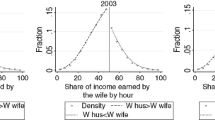Abstract
Families are allocating their time in an increasingly market-oriented fashion, with a decreasing proportion of labor hours being devoted to unpaid work. This article analyzes two aspects of the changing allocation of time. First, using longitudinal data from 1971 to 1991, the nature of the changes in how the families have changed their allocation of time between market and non-market alternatives is examined. Next, how family types have changed their allocations over the same period are examined. The Panel Study of Income Dynamics is used for this analysis.
Results of this research indicate that the proportion of time spent on household labor among men has increased over individual men's life cycles and between cross-sectional cohorts. However, women continue to devote more hours to household labor than men. The number of hours women spend in the labor force are increasing, but the number of hours women spend in the labor force is still less than the number of hours men spend in the labor force. While the families in the longitudinal analysis have been able to maintain fairly stable work and income patterns, the cross-sectional data indicate that families need to devote an increasing number of hours to the labor market to maintain economic stability.
Similar content being viewed by others
References
Ciscel, D. H., & Sharp, D. C. (1995). Household labor in hours by family type. Journal of Forensic Economics, 8(6), 115-123.
Coleman, J. S. (1990). Foundations of social theory. Boston: The Belknap Press.
DeLurgio, S. A. (1998). Forecasting principles and applications. Boston: Irwin McGraw-Hill.
Duncan, G. J., Hill, M. S., Morgan, J. N., & Hofferth, S. J. (1995). Panel Study of Income Dynamics 1968-1992 (Waves I-XXV) [Computer file]. Ann Arbor, MI: Survey Research Center [producer] at the University of Michigan (Duncan 1995). Ann Arbor, MI: Inter-University Consortium for Political and Social Research [distributor].
Heath, J. A. (1990). Nonemployed women, marriage and the Sisyphus syndrome. Journal of Economic Issues, 24, 103-114.
Heath, J., Ciscel, D., & Sharp, D. (1998). The work of families: the provision of market and household labor and the role of public policy. Review of Social Economy, 56(1), 503-523.
Sharp, D. C., Ciscel, D. H., & Heath, J. A. (1999). Back to Becker: Valuing women's economic contribution from housework with household production functions. Journal of Forensic Economics, 11(3), 215-235.
Author information
Authors and Affiliations
Rights and permissions
About this article
Cite this article
Ciscel, D.H., Sharp, D.C. & Heath, J.A. Family Work Trends and Practices:1971 to 1991. Journal of Family and Economic Issues 21, 23–36 (2000). https://doi.org/10.1023/A:1009475313602
Issue Date:
DOI: https://doi.org/10.1023/A:1009475313602




